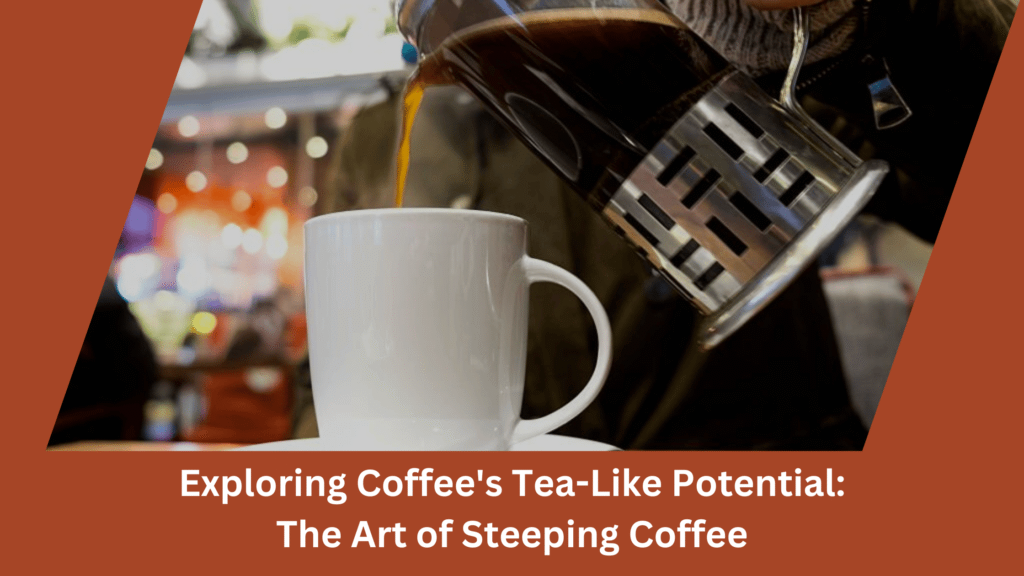Have you ever wondered if you can steep coffee like tea? It turns out, you actually can! While traditionally coffee is brewed through the process of hot water passing through ground beans, steeping coffee mimics the method used to prepare a warm and comforting cup of tea. By allowing coffee grounds to steep in hot water for an extended period of time, you can unlock a whole different flavor profile and experience coffee in a whole new way. So, if you’re looking to explore the depths of coffee brewing techniques, why not give steeped coffee a try?
Can You Steep Coffee Like Tea
If you’re a coffee lover who’s curious about trying new brewing methods, you may have wondered if it’s possible to steep coffee like tea. While steeping is a common process for infusing flavors in tea, it’s not typically associated with coffee. However, with some experimentation and a few adjustments to your brewing routine, you can indeed steep coffee like tea. In this article, we’ll explore the process of steeping, the properties of coffee and tea, different brewing methods for both, the pros and cons of steeping coffee, how to experiment with steeped coffee, and a comparison between coffee and tea steeping. We’ll also provide recommendations and common mistakes to avoid when steeping coffee.
1. Understanding Steeping Process
1.1 What is Steeping?
Steeping is the process of extracting flavors and aromas from solid materials, such as coffee beans or tea leaves, by immersing them in a liquid, typically hot water. This allows the liquid to absorb the desired properties of the solids, resulting in a flavorful beverage. While steeping is commonly associated with tea, it can also be applied to coffee for a unique brewing experience.
1.2 How Does Steeping Work for Tea?
In tea steeping, the hot water enhances the infusion of various compounds, including polyphenols, catechins, and essential oils, which contribute to the tea’s flavor and health benefits. The steeping time, water temperature, and tea-to-water ratio all play a crucial role in the final taste of the tea.
1.3 Can Coffee Be Steeped?
Coffee can be steeped, although it requires some adjustments compared to traditional brewing methods. Typically, coffee is brewed by passing hot water through coffee grounds, allowing for a quicker extraction and different flavor profile compared to steeping. However, by steeping coffee, you can experiment with different flavors and create a unique beverage.
2. Properties of Coffee and Tea
2.1 Characteristics of Coffee
Coffee beans contain a complex mixture of compounds, including caffeine, acids, oils, and sugars. These compounds contribute to coffee’s distinct flavor, aroma, and stimulating effects. The roast level and bean origin also play a significant role in determining the flavor profile of coffee.
2.2 Characteristics of Tea
Tea leaves come from the Camellia sinensis plant and can be processed in various ways to produce different types of tea, such as black, green, oolong, and white tea. The oxidation level of the leaves and the brewing technique greatly influence the taste, color, and aroma of the tea. Tea also naturally contains caffeine, although typically in lower amounts compared to coffee.
3. Brewing Methods for Tea
3.1 The Traditional Method
The traditional method of steeping tea involves pouring hot water over tea leaves in a teapot or cup and allowing them to steep for the desired duration. The steeping time varies depending on the type of tea and personal preference.
3.2 The Cold Brew Method
Cold brew tea is a popular method that involves steeping tea leaves in cold or room-temperature water for an extended period, usually overnight. This results in a smoother and less bitter tea that is often enjoyed over ice.
3.3 The Sun Tea Method
The sun tea method involves placing tea bags or loose tea in a jar with cold water and leaving it in direct sunlight for several hours. The sun’s heat slowly extracts the flavors from the tea, creating a refreshing and mellow beverage.
4. Brewing Methods for Coffee
4.1 The Traditional Brew Method
The traditional brewing method for coffee involves pouring hot water over coffee grounds in a filter, allowing the water to pass through and extract the flavors as it drips into a coffee pot or cup. This method is known for its efficiency and is commonly used in drip coffee machines.
4.2 The Cold Brew Method
Similar to cold brew tea, cold brew coffee involves steeping coffee grounds in cold or room temperature water for an extended period, typically 12 to 24 hours. The resulting coffee is smoother, less acidic, and often diluted with water or milk before consuming.
4.3 The French Press Method
The French press brewing method involves combining coffee grounds with hot water in a cylindrical container, letting it steep for several minutes, and then pressing down a plunger with a metal mesh filter to separate the liquid from the coffee grounds. This method allows for a fuller-bodied coffee with more oils and sediment.
5. Steeping Coffee – Pros and Cons
5.1 Advantages of Steeping Coffee
Steeping coffee allows for a different flavor profile compared to traditional brewing methods. It can result in a smoother, less acidic taste, while still extracting the desired flavors and aromas from the coffee beans. Steeping also provides an opportunity to experiment with different coffee beans and create unique flavor combinations.
5.2 Disadvantages of Steeping Coffee
One of the main disadvantages of steeping coffee is the requirement for longer steeping times compared to other brewing methods. This can be inconvenient for those seeking a quick cup of coffee. Additionally, steeping may not extract the same level of caffeine as the traditional brewing methods, resulting in a milder stimulant effect.
6. Experimenting with Steeped Coffee
6.1 Steeped Coffee Flavors
Steeping coffee opens up a world of possibilities for experimenting with flavors. By adjusting the steeping time, water temperature, and coffee-to-water ratio, you can explore different taste profiles and discover unique nuances in your coffee. This experimentation can lead to exciting flavor discoveries and provide a heightened sensory experience.
6.2 Alternative Steeping Techniques
In addition to adjusting the steeping parameters, you can also experiment with alternative steeping techniques for coffee. For example, using a French press to steep coffee can result in a rich, full-bodied brew. Another method is the “cupping” technique, commonly used in coffee tasting, where you combine ground coffee with hot water in a cup and let it steep before tasting and evaluating the flavors.
7. Comparing Coffee and Tea Steeping
7.1 Flavor Profiles
The flavor profiles achieved through steeping differ between coffee and tea. Tea often has a delicate and nuanced flavor, with the ability to showcase a variety of floral, grassy, or earthy notes. Coffee, on the other hand, tends to have bolder and more robust flavors, often with hints of chocolate, fruit, or nuttiness.
7.2 Caffeine Content
Coffee is typically higher in caffeine content compared to tea, although this can vary depending on the type and brewing method used. Steeping coffee may not extract the same amount of caffeine as traditional brewing methods, so if you’re looking for a strong caffeine boost, it may be better to stick with the traditional methods of brewing coffee.
7.3 Brewing Time
Steeping coffee generally requires a longer brewing time compared to tea. While tea can be steeped in just a few minutes, coffee often benefits from a more extended steeping period, ranging from a few minutes to even several hours for cold brew coffee. This difference in brewing time allows for different compounds to be extracted and contributes to the distinct flavors of each beverage.
8. Recommendations for Steeping Coffee
8.1 Choosing the Right Coffee Beans
When steeping coffee, it’s essential to choose high-quality coffee beans that align with your flavor preferences. Experiment with different roast levels, origins, and blends to find the beans that produce the desired flavors when steeped. Consider consulting with a local coffee roaster or knowledgeable barista for recommendations based on your preferences.
8.2 Proper Water Temperature
The water temperature used for steeping coffee can greatly impact the final taste. Generally, a water temperature between 195 to 205°F (90 to 96°C) is recommended for steeping coffee. However, depending on the coffee beans and your personal preferences, you may choose to adjust the temperature slightly higher or lower to achieve the desired flavor profile.
8.3 Steeping Time and Ratios
Experiment with varying steeping times and coffee-to-water ratios to find your preferred balance. The steeping time can range from a few minutes to several hours, depending on the brewing method and desired intensity. Keep in mind that longer steeping times can result in a stronger flavor but may also lead to over-extraction and bitterness, so it’s essential to find the right timing for your preferences.
9. Common Mistakes to Avoid
9.1 Over-Steeping
One common mistake when steeping coffee is overstepping, which can result in a bitter and unpleasant taste. Be mindful of the steeping time and adjust it according to your desired intensity. Consider starting with shorter steeping times, gradually increasing if desired, to avoid over-extracting flavors.
9.2 Using Incorrect Ratios
Using incorrect coffee-to-water ratios can also affect the final taste of your steeped coffee. Too much coffee relative to the amount of water can lead to an overpowering and bitter brew, while too little coffee can result in a weak and diluted flavor. Experiment with different ratios until you find the ideal balance for your taste preferences.
9.3 Not Experimenting with Different Beans
One of the joys of steeping coffee is the opportunity to experiment with different coffee beans. Don’t limit yourself to a single variety or blend. Try exploring various origins, roast levels, and flavor profiles to discover new and exciting combinations that suit your palate.
In conclusion, while steeping coffee is not the traditional brewing method, it offers a unique and enjoyable way to experience the flavors and characteristics of different coffee beans. By adjusting the steeping parameters, experimenting with various beans, and avoiding common pitfalls, you can unlock a world of possibilities and create your own personalized steeped coffee experience. So go ahead, grab your favorite coffee beans, a cup, and give steeping a try – you may just discover a new favorite way to enjoy your caffeine fix!



